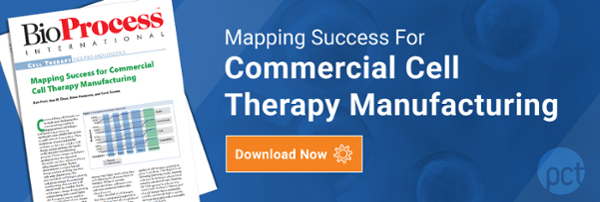If you’re reading this, you’ve no doubt already discovered that cell therapy manufacturing comes with its share of specific challenges, no matter what phase of development you are in, from pre-clinical to (if you're lucky) post-commercial launch. In the beginning, those challenges include clearly defining your quality target product profile. At commercialization, they include scaling up manufacturing enough to meet—but hopefully not exceed—market demand. Wherever you are on this spectrum, it’s important to know what you need to prioritize, what obstacles to expect, and how to meet them strategically and head-on.
This is the first in a three-part series on addressing those challenges.
We begin with advice from Lewis Carrolls’ Alice’s Adventures in Wonderland: “Begin at the beginning, and go on till you come to the end. Then stop.”

For cell therapy manufacturing, the beginning (pre-clinical/Phase 1) means completing your quality target product profile (QTPP) and planning ahead to implement Development by Design, a manufacturing concept and strategy that places key emphasis on quality, cost of goods, scalability and sustainability throughout the entire process.
The QTPP is developed and maintained to detail the targeted post-manufacturing product attributes needed to support safety and efficacy of the product. While there is certainly latitude in how a QTPP is constructed, a recommended format provides the following categories of information:
- Characteristics profile (e.g. description, formulation, dosage, potency, volume, shelf life)
- Safety profile (e.g. microbial assurance, cellular impurities, manufacturing residuals)
- Use profile (e.g. indications for use, treatment timing, preparation and use)
- Business profile (e.g. geographies, market projections, clinical/commercial milestones, cost of goods targets, IP)
In conjunction with developing the QTPP (a process through which a development and manufacturing organization with cell-therapy specific knowledge should be able to guide you), it’s crucial to think about a manufacturing process that takes into account Development by Design—the consideration of quality, cost of goods, scalability, and sustainability—as follows:
QUALITY: Quality is certainly foundational, as recognized by Quality by Design, but for cell therapy—where there is heavy reliance on the process to meet critical quality attributes (CQAs) of the final product—the manual, open, and human-dependent nature of many process steps presents substantial risk. As the basis for manufacture, the product mechanism of action must be understood in vivo and then a means to measure it ex vivo must be determined. A robust process with validated ability to produce products of consistently high quality is critical. Automation, integration, and closed-system design are key tactics to elevate robustness of the process.
COGS (COST OF GOODS SOLD): The current high COGS of cell therapy products (typically driven by labor and testing costs for patient-specific products and by media for off-the-shelf products) usually demands a sizable commercial value proposition. As processes mature, the focus on COGS for commercial viability becomes critical. Development by Design allows for prospective approaches to addressing COGS appropriate for scale and stage of development.
SCALABILITY: Migrating from a clinical-scale process with the capacity to make tens to hundreds of patient doses per year, on to a commercial-scale process with the capacity to make thousands to ten-thousands of patient doses, can present significant comparability risks. In particular, cell therapy products inherently possess high complexity with one or more mechanisms of action that are often incompletely understood. In addition, although there are a number of analytical tools to assess product quality, establishing a direct link to the product mechanism of action has proven difficult for many products. This uncertainty may create comparability risk when implementing process development changes required to scale up the process, such as is required for an off-the-shelf cell therapy. Time and cost are also a concern when it comes to comparability risk—cell therapy developers may be hesitant to change the manufacturing process at all for fear of having to repeat trials due to lack of comparability.
SUSTAINABILITY: Finally, even if quality, COGS, and scale objectives have been met, there is the very real risk that manufacturing cannot be sustained over the full product life cycle. To mitigate risks to sustainability, companies need to assess the full range of supply chain inputs to the manufacturing process, including reagents, consumables, equipment, and human resources. Additionally, the assessment should methodically include every unit operation, both process and testing.
Considering these elements early on, with the help of a trusted manufacturing partner that is well-versed in cell therapy, will give your product the leverage to begin its development and manufacturing journey from the most strategic, efficient, effective possible starting point. In part two, we’ll consider the challenges that come next, in Phase 2/3.
Click the image below to download the complimentary article, "Mapping Success for Commercial Cell Therapy Manufacturing."
